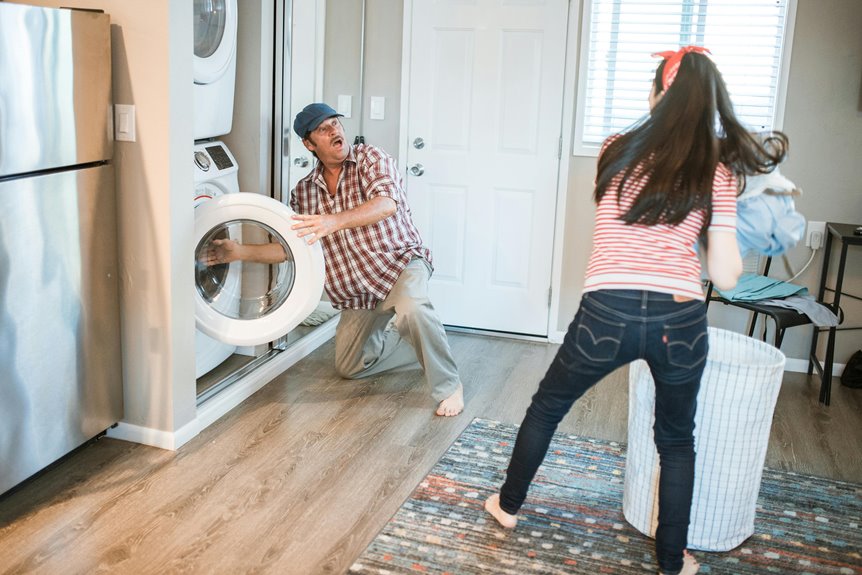While you might think cleaning a viscose rug requires expensive specialty products, I’ve discovered it’s more about technique than fancy solutions. After ruining my first viscose rug years ago, I’ve mastered the art of keeping these delicate floor coverings pristine without damaging their silky fibers. If you’re worried about maintaining your viscose rug’s luxurious sheen, I’ll share my proven method that’s saved countless rugs from common cleaning disasters.
Understanding Viscose Fiber Properties and Sensitivities

While viscose rugs can add elegance to any room with their silk-like sheen, I need to warn you about this delicate fiber’s unique characteristics.
When it comes to viscose durability, I’ve learned that these rugs are incredibly vulnerable to moisture, stains, and foot traffic, making them best suited for low-traffic areas in your home.
The fiber sensitivity of viscose means it can quickly become damaged if you’re not careful with cleaning methods.
I’ve seen how water can cause viscose fibers to yellow, weaken, and even shed, while harsh chemicals can permanently destroy the rug’s delicate structure.
That’s why I always tell my readers to avoid placing these rugs in bathrooms, kitchens, or entryways where they might encounter spills or moisture.
Essential Tools and Materials for Safe Cleaning
Before you begin cleaning your viscose rug, I’ll help you gather the gentle yet effective tools that won’t damage its delicate fibers.
I’ve tested numerous cleaning solutions and tools over the years, and I know exactly what works best for these sensitive rugs. You’ll want to keep your cleaning supplies minimal but targeted for the best results.
- White microfiber cloths or soft, lint-free white towels for blotting
- A vacuum with adjustable height settings and soft brush attachment
- Mild, pH-neutral cleaning solution specifically formulated for delicate fibers
- Clean spray bottle filled with distilled water for gentle misting
Remember to store these cleaning tools separately from your regular household cleaners to avoid any accidental mix-ups that could harm your viscose rug’s delicate fibers.
Preventive Care and Maintenance Tips
Since proper maintenance can extend your viscose rug’s life by several years, I’ve developed a set of preventive care tips from my experience with these delicate floor coverings. Through regular maintenance and smart preventive measures, you’ll keep your rug looking beautiful for longer.
| Area | What to Do | What to Avoid | Frequency |
|---|---|---|---|
| Traffic | Rotate rug | Walking with shoes | Every 3 months |
| Sunlight | Use curtains | Direct exposure | Daily |
| Spills | Blot immediately | Rubbing motion | As needed |
| Dirt | Vacuum gently | Beater bars | Weekly |
I recommend placing your viscose rug in low-traffic areas and using rug pads underneath to prevent slipping. Keep pets’ nails trimmed and consider using runners in high-traffic areas to protect your investment.
Spot Cleaning Techniques for Fresh Stains

Anyone dealing with a fresh stain on a viscose rug needs to act quickly and carefully to prevent permanent damage.
I’ve found that effective blotting with a clean white cloth is your best first defense against most fresh stains. When I help my clients with fresh stain removal, I always remind them that the key is to work from the outer edges toward the center to prevent spreading.
- Never rub or scrub the stain, as this can damage viscose fibers and push the stain deeper.
- Use a minimal amount of plain, cold water on your cloth when blotting.
- Test any cleaning solution on an inconspicuous corner first.
- Blot with a dry cloth between applications to assess your progress.
If these steps don’t work, I recommend calling a professional immediately before the stain sets.
Professional Cleaning vs. DIY Methods
While DIY cleaning methods might seem cost-effective for your viscose rug, professional cleaning often proves the safer, more reliable choice for maintaining its delicate fibers.
I’ve seen too many viscose rugs damaged by well-meaning owners using harsh cleaning products or excessive moisture.
Professional services have specialized equipment and expertise to handle your rug’s unique needs. They’ll test the fibers, use appropriate cleaning solutions, and control moisture levels throughout the process.
If you’re determined to clean your rug yourself, I recommend consulting the manufacturer’s guidelines first.
However, I’ve found that the cost of professional cleaning every 12-18 months is worth it to protect your investment.
Common Cleaning Mistakes to Avoid
Many viscose rug owners make well-intentioned but damaging mistakes when cleaning their rugs at home, and I’ve seen these errors lead to permanent fiber damage.
When it comes to proper rug care, I want to help you avoid the most common cleaning techniques that can ruin your viscose fibers.
- Never scrub or rub your viscose rug vigorously, as this causes fiber distortion and matting that you can’t reverse.
- Avoid using hot water or steam cleaning, which weakens the delicate viscose fibers and can cause shrinkage.
- Don’t saturate your rug with excessive water or cleaning solutions, as viscose is highly absorbent and prone to browning.
- Skip harsh chemical cleaners and bleach-based products that break down the natural fibers and cause discoloration.
Drying and Recovery Procedures

Since proper drying is crucial for preventing permanent damage to your viscose rug, I’ll walk you through the essential recovery steps after cleaning.
First, I recommend using clean, white towels to blot excess moisture from your rug’s surface, working from the edges toward the center. Don’t use fans or heated drying techniques, as they can cause uneven drying and fiber distortion.
For the best recovery methods, lay your rug flat in a well-ventilated indoor space, away from direct sunlight and heat sources.
I suggest flipping it every few hours to guarantee even drying on both sides. Once it’s completely dry, I’ll have you gently brush the fibers in their natural direction using a soft-bristled brush to restore the rug’s texture and appearance.
Long-term Storage and Protection Strategies
To keep your viscose rug in pristine condition during long-term storage, I’ll share my proven protection strategies that’ll safeguard its delicate fibers.
When it comes to storage solutions, I always recommend using climate-controlled spaces to prevent moisture damage and fiber deterioration. I’ve found that proper protection measures make a significant difference in maintaining your rug’s beauty over time.
- Roll your rug around a cardboard tube rather than folding it, which can create permanent creases.
- Wrap the rolled rug in breathable cotton or muslin cloth, avoiding plastic that can trap moisture.
- Place cedar blocks or mothballs at regular intervals to prevent pest infestations.
- Store the rug elevated off the ground on a sturdy rack or shelf to protect from flooding and pests.







